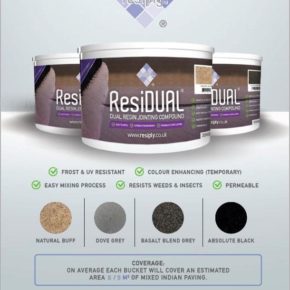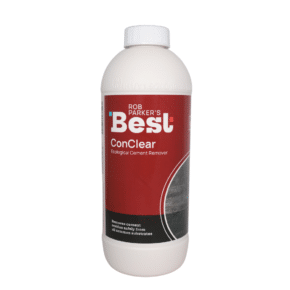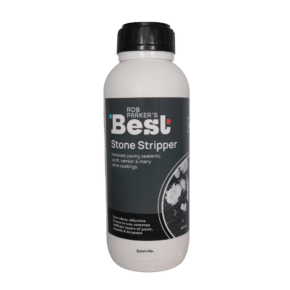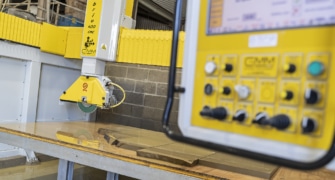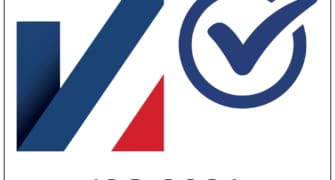Pointing patio slabs is one of the last and also most important steps in getting your patio to look flawless and professional. There are various types of pointing patio slabs, and each of them has advantages in certain situations. In this blog, you will discover which type of pointing your patio has, and therefore which type of product will remove any stains left after the pointing has been completed.
What is pointing?
Pointing patio slabs is the task of filling the gaps left between the paving slabs after a patio has been laid.
At Stoneworld, we deal with a lot of enquiries about pointing patio slabs. This can be at the time a customer is buying their paving stone from us. They may ask our advice on what is the best pointing compound to use on their patio. We also deal with a lot of enquiries about how to clean up after pointing has been completed. The reason for this is that pointing is the last job that needs to be done to complete a patio. It is a job that needs to be done carefully and precisely. Sometimes stains occur on the paving when pointing is not completed perfectly. If pointing mixture is not cleaned up immediately, deposits can set hard on the paving surface and become tricky to remove.
What do I need to clean stains off my patio after the pointing has been done?
Do not worry if this has happened to you. There are specialist products are available to help remove these stains. The earlier they are tackled the better, i.e. they should be thoroughly washed away before they have a chance to dry and set, but if for some reason they have set, do not despair!
Before purchasing a product to remove your pointing stain, first check what type of compound has been used.
What type of pointing do I have?
Pointing a patio is either done using a cement-based pointing mixture or a resin-based jointing compound.
What is cement-based pointing?
There are two types of pointing compound most commonly used to point patios. Traditionally, patios were pointed using a mortar based compound, formed from sand and cement. This is a similar compound to what is used to build houses, except that the sand used is finer. Typically it will be a 4:1 ratio of kiln dried sand to cement. There are also various methods of application, used by landscapers working with this traditional pointing mixture. Some favour a dry mixture brushed between the joints, that is then moistened in situ via a watering can. There are others that favour moistening the pointing mixture before application, using a pointing trowel to carefully push the mortar mix down between the paving slabs.
Both methods require care to ensure that excess mortar is not left on the paved surface. If left, these excesses will become hard and difficult to remove. The hardened deposits may present as lumpy deposits on the paving. Alternatively, a dull cloudy film can form over the paving (this is likely to occur with the dry mix method, or if the cleaning up rinse off is inefficiently done leaving cement particles on the paved surface).
What is resin-based pointing compound?
If you do not have cement-based pointing it will be a resin-based jointing compound. This is the modern way to point a patio At Stoneworld, we recommend ResiDUAL which is a very reliable compound that will last for years without degradation. Resin-based jointing compounds contain polymers that mix with sand to create a very strong mixture. They are easier to manage than cement-based compounds and make a tricky job much quicker and easier. However, mistakes can still happen, and stains may need to be removed.
ResiDUAL
Why are there different types of pointing?
As with most things in life, new developments occur in our industry. Some are adopted sooner than others. We estimate that 50% of our landscapers have now converted to ResiDUAL, our favoured resin based jointing compound. Traditionalists are still working with cement-based pointing mixtures.
What is the difference between pointing and jointing compounds?
There is no difference in the terms used, pointing mixture and jointing compound mean the same thing, but it is the composition that needs to be checked. Check if the mixture is cement-based or resin-based. This is especially important if you require a product to clear up after the job, as different spills need different products. If you have a resin-based jointing compound, you will not be able to remove it with a cement remover.
We have noticed that a number of customers have been advised to use interior flooring grouts on their Indian sandstone paving. However, this product is not suitable for this use. We urge you not to use interior flooring grouts on your Indian sandstone, unless the stone has been thoroughly sealed with our patio sealer first. By thoroughly, we mean until the stone will not absorb any more sealer at all! Indian sandstone is a porous stone and these interior grouting products have such small particles that they are very easily absorbed by the sandstone slabs, creating an almost irremovable stain on the stone. We believe the only way to remove this stain is by using a sandblaster- not something readily available to many.
*Please do not use interior floor grout to point an Indian Sandstone patio.*
What is the best pointing compound?
As previously mentioned, we recommend ResiDUAL, a resin-based jointing compound, as it makes a tricky job much quicker and needs no maintenance once set. ResiDUAL joints will last for many years unaffected by British weather conditions.
Resin-based jointing compounds are easy to use. The active ingredients are mixed together and then combined with kiln dried sand. One kit will include the measured quantities you require to mix with 1 x 20KG bag of kiln dried sand. At Stoneworld this is sold as a kit. Each kit will cover 8-9sqm. Once mixed, the compound is brushed over the surface of the newly laid paving where it falls into the jointing gaps.
Thorough rinsing is a very important part of this process. Failure to do so can result in extremely tough deposits left on the paving. Anything other than superficial staining can be very tricky to remove, but excess compound is very obvious on a surface and can be removed easily whilst still unset using sweeping and rinsing.
Where can I buy resin based jointing compound?
We sell ResiDUAL at Stoneworld. You can order it on our website, or give us a call on 01844 279274 to place your order.
However, no system is fool proof. Unfortunately when user error occurs, steps will need to be taken to restore the paving. If you are facing this problem, give us a call and we will advise you on how to restore your paving.
How do I clean up cement stains caused by mortar-based pointing?
We recommend Rob Parker’s Best ConClear to remove all cement-based mortar spills and stains. It is a highly effective, safe and ecological solution. ConClear is far safer than brick acid, a product long favoured by builders.
At Stoneworld, we strongly advise against using brick acid. It can eat into the surface of stone and ruin it. ConClear is an inert substance that does not react with other surfaces; it is totally safe on stone. It will react with mortar creating a soft substance that can be washed away.
Rob Parker’s Best ConClear
How do I clean up stains caused by resin-based jointing compounds?
We recommend removing resin-based pointing stains with Rob Parker’s Best Stone Stripper, which is specially formulated to dissolve polymer-based substances such as resin, glue, varnish and paint.
Rob Parker’s Best Stone Stripper
In some circumstances it may be necessary to buy both products.
Even if the pointing is a resin–based compound, where stains would require Rob Parker’s Best Stone Stripper to be used, the paving itself will be laid on a cement-based mortar mix. Failure to keep a clean workspace may mean that cement–based stains also occur. E.g. dusty cement footprints left overnight between work–days, may become moist from dew or rain, and then set on the surface. These can be removed with Rob Parker’s Best ConClear.
Pointing a patio is a job that takes care
We recommend that extreme care is taken when pointing a patio to avoid spillages and stains occurring.
The specialist products we recommend here will remedy mistakes made, but care taken at the outset will save extra time and expense later.
User error can also occur when using these products to clear pointing stains. These generally happen when the wrong product is selected for the job. Please research your chosen products first to ensure you buy the correct product and follow the instructions carefully for great results.
If you have any questions, please call us on 01844 279274 or email us at sales@stoneworld.co.uk and our team will be happy to help.


